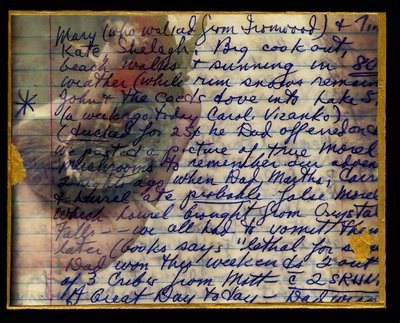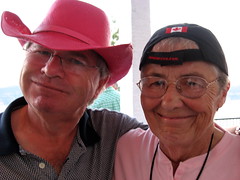Firing away at Coast Guard plan
Machine-gun proposal hits rough waters
By DAN EGAN
degan@journalsentinel.com
The U.S. Coast Guard has spent its entire history building an incredible reservoir of goodwill in the Great Lakes.
From the countless rescues of distressed mariners to the ice-breaker Mackinaw's annual Lake Michigan run with a load of North Woods Christmas trees for Chicago's needy, people on the lakes - drunken boaters excluded - have always been happy to see the bright red ships steaming their way.
And then the agency got its new machine guns and quietly announced in August a desire to create 34 massive - and permanent - firing ranges for a weapon that can shoot 10 lead bullets a second. It was, the Coast Guard explained, all about steeling its crews for the war on terrorism.
But now it is the agency itself that has a lot of people terrified, both in the U.S. and across the lakes in Canada, which shares ownership in the world's largest freshwater system, a drinking source for millions.
The major worries:
• The potential dangers associated with annually dumping in the lakes more than 3 tons of lead in the form of spent bullets.
"We run the risk that terrorists have succeeded in getting us to poison our own lakes without ever having set foot in the Great Lakes basin," said Hugh McDiarmid Jr. of the Michigan Environmental Council.
• Safety of recreational boaters and commercial operators who might tragically stray into one of the Coast Guard's designated "safety zones" during a live-fire exercise.
"When people are thinking of where they're going to go fishing, are they going to go to the place that's quiet? Or the place where people are shooting?" asked Duluth Mayor Herb Bergson. "It's not a good tourism thing."
• An increased militarization of what has been a famously non-militarized border between the U.S. and Canada.
"Canada is not harboring terrorists planning a marine assault on the United States across the Great Lakes," Green Party of Canada leader Elizabeth May said in a news release this month. "The notion is ludicrous."
The plan, initially released in the relatively obscure Federal Register in August, was put on hold at the end of the summer after an outcry from environmental and boating communities, as well as regional politicians.
The Coast Guard now is going to great pains to tell its side of the story. At the same time, it expanded the public comment deadline from Aug. 31 to Nov. 13. It is holding nine public hearings across the region, including one Wednesday in Waukegan, Ill., and another Nov. 8 in Sturgeon Bay.
Standing at a podium flanked by a painting of an icebreaker and another of a helicopter hovering over someone clinging to a swamped boat, Coast Guard Capt. Bruce Jones made no apologies for a plan that has so many people appalled during a news briefing held last week at the Milwaukee Coast Guard station.
He said the guns are needed "to ensure that our crews are prepared to respond to any future threat or increase in threat level on the Great Lakes - including our 13 nuclear power plants, 22 high-capacity passenger vessels and ferries and 11 major ports."
Added protection
Coast Guard crews have long been equipped with weaponry, typically handguns, shotguns and M-16 machine guns.
Jones said the firing zones are needed now because crews need to train regularly on the new, more powerful M240-B machine guns. Thirty-four such zones are required to ensure efficient use of manpower; crews that train close to their base, he said, will still be available for search-and-rescue calls. There are 14 proposed zones on Lake Michigan alone, including one about 10 miles east of downtown Milwaukee. All of the proposed zones are at least five miles from shore. The guns can fire a maximum distance of about two miles.
Jones said the zones would be used sparingly - each "several" times a year for three or four hours - and that the areas will otherwise be open to the public. He added that the Coast Guard would try to conduct the training in off-summer months when recreational boats typically don't ply the mid-lake waters but said the agency wanted to retain the right to use the firing ranges any time of year. Coast Guard officials say they need to train on water in order for crews to learn how to safely and accurately use the guns in the real-life scenarios they may encounter.
Jones said warnings would be broadcast on marine-band radio before any bullets are fired, and a second watch boat equipped with radar would be on the lookout so crews could intercept wayward sailors before they strayed into the live-fire zones.
He called the volume of lead deposited in the water and its effects on the environment "negligible," and pointed to an 82-page environmental study the Coast Guard paid an outside engineering firm to conduct as evidence.
Environmental groups may not like the idea of all that lead going into the lakes, but Richard Rediske, an expert in environmental chemistry and aquatic ecology from Michigan's Grand Valley State University, agreed that the small chunks of lead on the bottom of the middle of lakes pose little risk to the environment or human health.
Maybe that's true, said McDiarmid of the Michigan Environmental Council, but he won't be thoroughly convinced until the Coast Guard conducts an exhaustive environmental impact statement on the proposal.
Passive past
For some, the biggest issue is the potential to disrupt the pacific history the U.S. and Canada have enjoyed on their shared Great Lakes.
The smooth sailing started just after the War of 1812, when the two countries signed the Rush-Bagot Agreement of 1817, which limited the number of naval weapons each country could employ on the Great Lakes to three 18-pound cannons.
That treaty worked well for more than a century, but Canada recognized it was too dated to be relevant when it approached the U.S. following World War II and asked to take another look at it.
The countries entered into a new arrangement in which both sides agreed ship-based armaments could be increased for training purposes, provided each country gave the other detailed information about the new weaponry.
So when the Coast Guard decided it wanted its crews to carry bigger guns three years ago, the U.S. sent a delegation to Canada.
Canada's formal response: Not a problem. In fact, the weapons proposed were of such small caliber that officials with the Canada Department of Foreign Affairs and International Trade said the guns would not trigger consultation under the Rush-Bagot Agreement.
The Coast Guard moved ahead, and training began on the lakes last winter in several temporary firing zones.
The Canadian federal government might have signed off on the new weapons, but local Canadian leaders have made it clear in recent weeks they are not happy with the plans for training ranges on the shared lakes.
Similar worries exist on this side of the border.
Dan Thomas, president of the Great Lakes Sport Fishing Council, has gotten over his initial hostility toward the plan. But he still has problems with the proximity of the live-fire zones to shore and the way the Coast Guard went about announcing the proposal.
"Basically, the Coast Guard shot themselves in the foot on how they initially went about in not informing us," he said. "It (followed) the law, but it certainly wasn't appropriate. It violated . . . the excellent relationship that the Coast Guard and recreational boating communities have had for so many decades."
Jones, the Coast Guard captain, doesn't disagree that more could have been done to notify the public.
"In retrospect, that was a mistake," Jones said. "And we're making up for it now."
That doesn't mean people still won't have problems with the plan.
One of the things that upsets Cameron Davis of the conservation group Alliance for the Great Lakes is the scope of the training ranges, which cover 2.5% of the lakes' surface, or more than 2,300 square miles.
He worries the proposal could have a bigger impact on the future of the lakes than some people think.
"As far as the ecology of the lakes, there are much bigger issues than this," he said. "However, if people are scared to go out on the lakes, they won't love the lakes. And if they don't love the lakes, why will they care for them?"















































